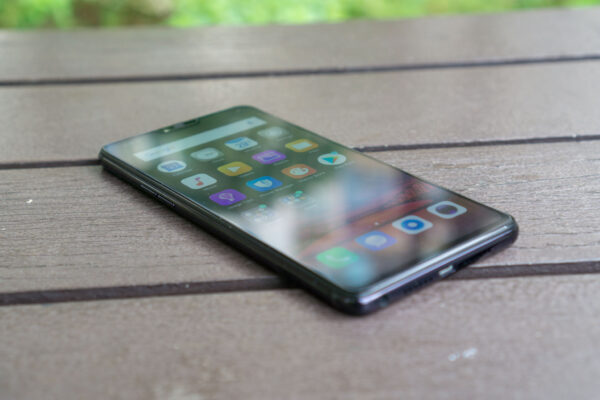
The trend for new smartphones this year is to feature a notch, 19:9 display aspect ratio, and play big on AI. OPPO has all that checked in two new flagship smartphones they launched a few weeks back: R15 and R15 Pro. Here’s my review of the OPPO R15.
The OPPO R15 is beautiful, very beautiful. It’s svelte body packs a huge 6.28-inch screen, dual rear cameras with 16 MP + 5 MP sensors, and a 20 MP front camera. It’s technically a mid-range smartphone, though one perhaps at the very top-end of that range. This smartphone has a heavy focus on camera shooting capabilities.
Every flagship smartphone nowadays all look good. Trying to stand out is getting increasingly more difficult. The OPPO R15 manages to still do that, with a design that is strikingly beautiful. It has glass on both front and back, with a sturdy aluminium frame within. The 3D glass is exceptionally gorgeous because of how light gets reflected off it in mesmerising colour gradients.
The OPPO R15 is thin, and reasonably light. It measures 155.1 x 75.2 x 7.4 mm, and weighs 175 grams.
It’s 2018, and we’re now seeing several smartphones with a front that is almost all-screen. On the OPPO R15, the 6.28-inch display has a screen ratio of 90%. The R15 uses an OLED screen with 2280 x 1080 resolution, 401 PPI pixel density, and 19:9 aspect ratio. The screen is bright, colours are very vibrant, and the specifications put contrast ratio at 60000:1.
The all-screen design means, with the exception of one smartphone that chose to go with a pop-up selfie camera, that a notch is needed at the top of the display to give space for the front camera and other sensors. The software helps make the gap in the display created by the notch less obvious. Given the 19:9 aspect ratio, even if apps in full-screen mode avoided using the topmost part of the screen, you don’t really feel like you lost some display area.
The OPPO R15 has the power button and volume rocker on different sides. The former is on the right side, together with the SIM card slot. This smartphone accommodates two nano-SIM cards, and supports a microSD card in-place of the second nano-SIM position.
A pair of speaker grills sit on either side of a Micro-USB port on the bottom of the OPPO R15. Given how otherwise very modern the OPPO R15 is, and that it’s already 2018. it seems quite disappointing to not get a USB Type-C port here. This smartphone does, however, support fast charging with OPPO’s VOOC Flash Charge.
Oh, I’m delighted to see there’s a 3.5 mm headphone jack there at the bottom.
The top of the OPPO R15 is quite featureless, though you might notice a microphone hole up there.
On the back, you’ll fnd the dual camera setup, with 16 MP + 5 MP sensors, having f/1.7 and f/2.2 apertures respectively. The rather pronounced rear camera bump may be a concern to some users.
The OPPO R15’s fingerprint sensor is on the back. It works fast, and I had no trouble with it.
You can also unlock the OPPO R15 using facial recognition. You can just lift the smartphone to activate face scanning, and the recognition works pretty fast I found, however, that I could unlock the OPPO R15 even when my eyes are closed, so depending on your security needs, this could be an issue for you.
Under the hood, the OPPO R15 is powered by a MediaTek Helio P60 64-bit octa-core processor clocked at 2.0 GHz. It has 6 GB of RAM and 128 GB of flash storage. Storage can be expanded to 256 GB via a microSD card.
The OPPO R15’s connectivity options include 4G cellular, dual-band 802.11a/b/g/n/ac Wi-Fi, and Bluetooth 4.2. There is no NFC, unfortunately.
The battery has 3450 mAh capacity. I found the OPPO R15’s battery life quite impressive. It scored 4060 in Geekbench 4 Battery test, which is higher than most other smartphones.
The OPPO R15 has no certification for ingress protection, so that means you’ll need to avoid getting this smartphone wet.
With all the AI going on, the OPPO R15 has got plenty of software features. It runs ColorOS 5.0, based on Android 8.1. The software is pleasant enough, somewhat different from stock Android, but not too heavily skinned. Much of the software customisation is in the apps, particularly in camera features.
The OPPO R15’s camera recognises 120 scene types, and 16 tags are displayed on screen depending on what the software has identified (e.g. food, pet, landscape). For selfie lovers, the AI beauty technology enhances the accuracy of face recognition with 296 facial feature points, and makes beautification adjustments with consideration for gender, age, skin, colour, and skin texture. If you take wefies, the AI beauty technology can individually handle up to four faces in the same photo.
I’ll have some photo comparisons between the Google Pixel 2 XL, Huawei Honor 10, and this OPPO R15 posted up in due course.
In terms of performance, the OPPO R15 shows it stands in mid-tier category. Benchmark results aside, I have not been disappointed in casual day-to-day use of the OPPO R15. The smartphone delivers a fluid user experience, and I’ve had no issues or lags with web browsing, messaging, or social media apps.
In the box, the OPPO R15 comes with a fast charger, USB to Micro-USB cable, earbud-style headphones, a SIM eject tool, and a jelly protective case.
The OPPO R15 retails at S$749, and is available in Nebula Purple, Rouge Red, and Frost White.
Conclusion
At the top-end of a mid-tier smartphone, the OPPO R15 is beautiful, and has a really smart AI camera.
Pros:
- Very beautiful design
- Robust built
- Very capable camera with numerous AI scene modes
Cons:
- No NFC
- No water-resistance
